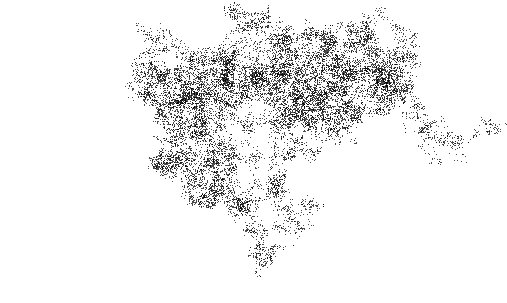Randomly Walking, Normally
To celebrate the glorious third day of Advent, after playing hooky the second day (ssshhh), I wanted to tackle Nature of Code's assignment on Gaussian distribution:
A Gaussian random walk is defined as one in which the step size (how far the object moves in a given direction) is generated with a normal distribution. Implement this variation of our random walk.
For context, we're given a Walker with two behaviors: 1) stepping to a new location, and 2) displaying. Displaying is the easy part; our Walker will be a pixel on a screen as shown in Processing below:
void display() {
applet.stroke(0); // Sets the color used to draw lines and borders around shapes
applet.point(x, y); // Draws a point, a coordinate in space at the dimension of one pixel
}As for stepping to a new location, that's where we're given the freedom to decide how our Walker acts. Our Walker may meander drunkenly from side-to-side, taking short little steps to preserve some balance in its life. Or, our Walker can leap forward, taking large steps like New York's most recent citizen injected with fresh hope of making it big only to crawl back to it's starting point.
Since this assignment concerns more for controlling the size of the step, our Walker may meander to one side. To bastardize Gaussian distribution in our context, our Walker will try to step by a given point (mean), but it may deviate from that point by some margin (standard deviation). In the algorithm below, I try to control the meandering by normalizing the mean; this should help the Walker not veer off completely once it has chosen a side. For instance, if we increase our mean to 3, our Walker will try, most of the time, walking 3 units in length to a side, quickly veering off the canvas.
void step() {
double choiceX = random.nextGaussian();
double choiceY = random.nextGaussian();
double std = 1.5;
int mean = 1;
x += 1 - ((int) (std * choiceX) + mean);
y += 1 - ((int) (std * choiceY) + mean);
}To let our Walker wander around, forward, back, side-to-side, I tweaked the standard deviation, std. High deviations may mean really large steps or really small steps. Smaller deviations will stick towards the supplied mean where the Walker may not move at all due to our controlled mean, mean.
I've supplied a couple examples below of the Walker doing it's thing:
One thing that becomes evident is that the canvas with a standard deviation of 1.5 seems darker. That's due to the Processing engine redrawing our Walker at smaller steps (i.e. smaller steps means pixels are more clustered together)

